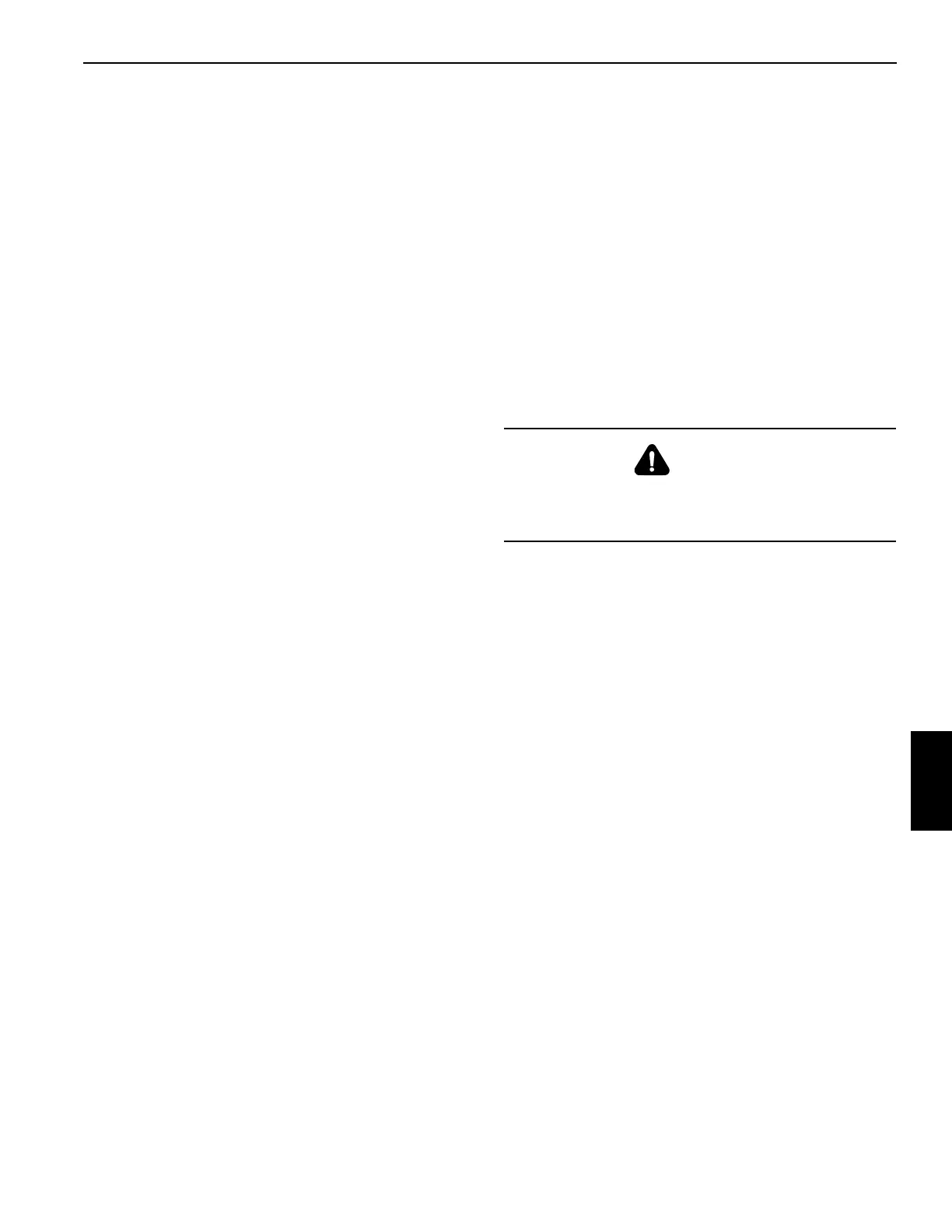Grove Published 11-10-2014, Control # 524-00 7-21
RT880E SERVICE MANUAL POWER TRAIN
Pressure Flushing
1. Disconnect both radiator hoses that connect the radiator
to the engine.
2. Clamp a convenient length of hose to the radiator core
outlet opening, and attach another suitable length of
hose to the radiator inlet opening to carry away the flush-
ing stream.
3. Connect the flushing gun to compressed air and water
pressure, and clamp the gun nozzle to the hose
attached to the radiator outlet opening.
4. Fill the core with water. Turn on air pressure in short
blasts to prevent core damage.
5. Continue filling the radiator with water and applying air
pressure as above until the water comes out clear.
6. Clamp the flushing gun nozzle firmly to a hose attached
securely to the engine water outlet opening. Fill the
engine block with water, partly covering the water inlet
opening to permit complete filling.
7. Turn on compressed air to blow out water and loose sed-
iment. Continue filling with water and blowing out with air
until flushing stream comes out clear.
8. For badly clogged water jackets that do not respond to
regular pressure flushing, remove the engine cylinder
head and core hole plugs, and with a suitable length of
small copper tubing attached to the flushing gun nozzle,
flush the water jackets through the openings.
9. When the vehicle is equipped with a water heater con-
nected to the cooling system, flush the heater, following
the same procedure as for the radiator core.
10. After completing the flushing operation, clean out the
surge tank overflow pipe; inspect the water pump; clean
the thermostat and the radiator cap control valves.
Check the thermostat for proper operation before instal-
lation.
11. Blow insects and dirt from the radiator core air pas-
sages, using water, if necessary, to soften obstructions.
Component Inspection
Radiator/Surge Tank
1. Side Tanks - Look for leaks, particularly where the tank is
soldered to the core. Vibration and pulsation from pres-
sure can fatigue soldered seams.
2. Filler Neck - The sealing seat must be smooth and
clean. Cams on filler neck must not be bent or worn so
as to allow a loose fitting cap. Ensure the overflow tube
is not plugged.
3. Radiator Cap - This is the pressure-setting type. Its pur-
pose is to hold the cooling system under a slight pres-
sure, increasing the boiling point of the cooling solution
and preventing loss of solution due to evaporation and
overflow.
The cap has a spring-loaded valve, the seat of which is
below the overflow pipe in the filler neck. This prevents the
escape of air or liquid while the cap is in position. When the
cooling system pressure reaches a predetermined point, the
cap valve opens and will again close when the pressure falls
below the predetermined point.
When removing the pressure type cap, perform the
operation in two steps. Loosening the cap to its first notch
raises the valve from the gasket and releases the pressure
through the overflow pipe. In the first stage position of the
cap, it should be possible to depress the cap approximately
0.13 in (3 mm). The prongs on the cap can be bent to adjust
this condition. Care must be taken that the cap is not too
loose as this would prevent proper sealing.
4. Tubes are very small and can become easily clogged by
rust and scale. The general condition of the cooling sys-
tem and operating temperature are indications as to
whether or not tubes are clean. Another good test is to
feel the core for cold spots.
5. Fins are thin metal sheets that dissipate heat picked up
by the tubes. They should be kept free of bugs, leaves,
straw etc., so as to allow the free passage of air. Bent
fins should be straightened.
Engine Water Jacket
The water jacket permits coolant to be circulated around the
cylinder walls, combustion chamber, and valve assemblies.
Some of these coolant passages are small and can easily
become clogged, if the cooling system does not receive the
proper maintenance.
1. Core Plugs - These are sometimes mistakenly called
freeze plugs. They do not provide protection against
freezing expansion, but are only present because of
engine block casting methods. Remove and replace
core plugs that show signs of leaking or rusting through.
Use an installation tool for core plug replacement.
2. Drain Plugs - The water jacket of each engine has one or
more drain plugs. These should receive seasonal care
and be kept free of rust and scale.
3. Gaskets - Gaskets must be in good condition to prevent
both internal and external leaks. If there are external
leaks around gaskets, there may also be internal leaks
into the engine. Proper tightening of the head bolts with
CAUTION
Loosen cap slowly and pause a moment to avoid possible
burning by hot water or steam. Continue to turn the cap to
the left until it can be removed.
